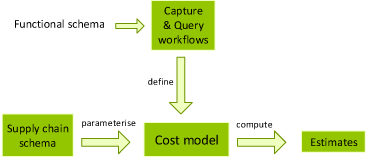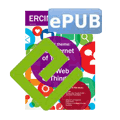TrakChain Estimates Costs for Track and Trace in the Internet of (many) Things
by Miguel L. Pardal and José Alves Marques
The TrakChain assessment tools take a description of a physical supply chain – relevant locations, how many goods are received, how often, etc. – and estimate the performance of track and trace queries in a modelled traceability system, providing predictions of how much processing and storage will be required for the working system. The tools were developed at Instituto Superior Técnico, Universidade de Lisboa, Portugal and were evaluated using a Pharmaceuticals supply chain case study.
The Internet of Things (IoT) promises benefits from a deeper connection between the virtual and physical worlds. One specific application area is logistics. The global economy depends on a wide range of supply chains that transfer goods from producers to consumers. The combined use of Enterprise Resources Planning (ERP) and Supply Chain Management (SCM) information systems has greatly improved the overall operational efficiency of supply chains. However, to achieve further improvements, more up-to-date and precise information about the supply chain is required.
RFID is an IoT technology that allows detailed and automated data capture in the supply chain, as specified by the EPCglobal standards [2]. Tags are attached to the objects of interest and readers placed along the supply chain locations generate event data, as illustrated in Figure 1.

Figure 1: Data about a physical object of interest, tagged with RFID, is captured along the supply chain. EPC IS is a standard for capturing and sharing event data.
A practical RFID traceability system should perform adequately for the large number of physical objects flowing in the supply chain [1]; and it should protect the sensitive business data from unauthorized access providing the desired data visibility [2]. The TrakChain project was proposed to evaluate both these aspects. It provides tools to estimate and measure the computational and communicational costs; and also security tools. The project was developed at Instituto Superior Técnico, Universidade de Lisboa, Portugal; in collaboration with researchers from the University of Cambridge, UK; and the Massachusetts Institute of Technology, USA; and was aligned with normalization efforts by GS1 for ’RFID data discovery services’ and ‘event-based traceability’.
Traceability Cost Models
The cost models can compare traceability systems for different supply chains, so that the best architecture for a given setting can be found. It helps to find answers for questions such as: Should the system be centralized or decentralized? Should data be copied to specific locations or referenced?
The data flow of the assessment tool is illustrated in Figure 2: given a supply chain characterization and system workflow specifications, the cost model can estimate processing times and data storage needs. The tool was validated with a case study in the Pharmaceuticals industry that compared solutions being proposed to ensure the authenticity of drugs [2].

Figure 2: Data flow of the TrakChain cost assessment tool.
Traceability Data Access Control
The supply chain participants need to trust that the traceability system will manage their data properly and enforce data access control, otherwise they will not share their data [3].
TrakChain implemented visibility restriction mechanisms that can be used to define and enforce access control policies using RDF and SPARQL. The policies can be converted to a standard format, XACML, to reuse existing enforcement infrastructures with certified management and audit tools.
The expressiveness of the policies was evaluated against a set of requirements for a real-world pharmaceutical traceability system, and it was shown to be expressive enough to satisfy the business requirements. For example, it can specify dynamic conditions to allow the sharing of data with business partners downstream in the supply chain that are not known in advance.
Future Work
More data attributes, such as expiry dates and temperature readings, can also be made available and controlled by the traceability system. The increase in the safety and quality of products is a good example of how the Internet of Things can help change the world for the better.
Link:
http://trakchain.net
References:
[1] M. L. Pardal, M. Harrison, and J. A. Marques: “Assessment of Visibility Restriction Mechanisms for Discovery Services”, IEEE International Conference on RFID, 2012.
[2] M. L. Pardal, M. Harrison, S. Sarma, and J. A. Marques: “Expressive RFID data access policies for the Pharmaceuticals supply chain”, IEEE International Conference on RFID, 2013.
[3] M. Eurich, N. Oertel, and R. Boutellier: “The impact of perceived privacy risks on organizations’ willingness to share item-level event data across the supply chain”, Journal of Electronic Commerce Research 10(3-4), 423–440, 2010. ISSN: 1572-9362.
Please contact:
Miguel L. Pardal
Instituto Superior Técnico, Portugal
Email:











